
Flame 2021 introduces new features aimed at innovating and accelerating creative workflows for VFX, color grading, look development, and editorial finishing.
Autodesk’s new Flame 2021 increases workflow flexibility for artists, expands A.I. capabilities with new machine learning-powered human face segmentation, and simplifies finishing for streaming services with new functionality for Dolby Vision HDR authoring and display. By popular demand, the release also adds a new GPU-accelerated Physical Defocus effect as well as finishing enhancements to make it easier to adjust looks across many shots, share updates with clients, and create beautiful work, faster.
“Flame allows artists to create at the speed of thought – whether iterating quickly for client reviews, adding finishing touches to shots, or creating beautiful content that meets modern streaming standards,” said Will Harris, Flame Family product line manager. “This latest release continues to build on powerful VFX and finishing workflows in Flame with new features that support the latest HDR standards and integrate even more uses of A.I. to accelerate the creative process.”
Building upon Flame’s A.I.
Flame’s powerful A.I. feature set introduced in April 2019 is taken to new levels in this edition of the software. The use of built-in machine learning analysis algorithms to isolate and modify common objects in moving footage, dramatically accelerating VFX and compositing workflows was a welcome addition to that version and continues to be a key feature for this new version.
Useful for compositing, color grading, and cosmetic beauty work, the A.I.-based face segmentation tool automates all tracking and identifies and isolates facial features, including nose, eyes, mouth, laugh lines, and cheekbones, for further manipulation. Face matching algorithms are also capable of specialized tasks, including specific mole or scar isolation, through custom layout workflows.
What’s new in Flame
The new Flame Family 2021 includes a series of improvements and features. Here are some:
- Machine Learning Human Face Segmentation: A new semantic keyer introduces the ability to isolate and extract alpha mattes for skin, eyes, lips, nose, and additional facial features via A.I. and machine learning with no manual tracking required.
- Dolby Vision HDR Authoring and Display Workflow: New HDR Dolby Vision implementation enables XML metadata import/export for collaborative workflows; adds Dolby analysis trim and target display viewing within Flame; and introduces eCMU, iCMU and HDMI metadata tunneling for viewing HDR content via SDR monitors and Dolby enabled TVs. Additionally, Flame’s multilayer edit timeline now includes a HDR track to keep Dolby Vision metadata in sync, make last-minute edit changes, finalize transitions, and integrate graphics.
- Physical Defocus: A new GPU-accelerated Defocus Effect makes it easier to add depth of field to shots and can be used in Batch as a standalone Matchbox node or in Image Selective in combination with a generated AOV Depth map. Choose between Physical and Action Camera focus models or create custom models by adjusting attributes. Lens artifacting and radial, chromatic aberration can be customized to achieve the level and quality of out-of-focus blur desired, Depth Slices can be increased and blended for more granularity of focus, and highlights can be bloomed using a selection of Bokeh attributes and lens noise models.
- Save and Recall Color Grading and VFX: Quickly save and recall color grading and VFX work in the new Explorer, a dedicated “grade bin” and reference comparison area to support artist workflows.
- Viewing Area: A new video preview mode shares artist viewports, including storyboard, manager, and schematic, to SDI or HDMI preview monitors. In broadcast mode, Gmasks can now be observed in the view area during editing along with any other tools you directly manipulate.
- GMask Pre-Made Shapes: New GMask pre-made shapes with softness are available for colorists, compositors, and finishing VFX artists in the image and action nodes.
A free virtual event
For a first-look at Flame 2021 and discussion on the latest tool updates for artist workflows, Autodesk will be hosting an upcoming webinar on April 28th with Andy Milkis, Director of Visual Effects and Technology at LVLY and co-founder of the New York Flame User Group. Interested participants can register to attend the free virtual event here.
Flame, Flare and Flame Assist 2021 are available at no additional cost to Flame Family 2020 subscribers. To learn more about the solutions from Autodesk follow the link.
